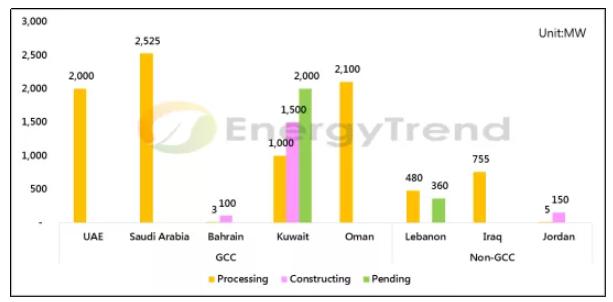
The Middle East - a global oil and gas production base. However, in recent years, the Middle East region has been favored by the international community for the reduction of greenhouse gas emissions and renewable energy technology, and under the influence of factors such as the fall in oil prices in 2014, the Middle East countries have begun to seek economic reform to maintain the government revenue and meet the growing electricity demand year by year. The application of photovoltaic power generation technology can not only effectively utilize the rich solar energy resources in the Middle East, but also meet the requirements of low technology cost. According to the survey of energy trend, the new energy research center of Jibang consulting, by the end of 2017, the cumulative grid connected capacity of photovoltaic power generation in the Middle East was 1.8gw, and by the first half of 2019, the cumulative grid connected capacity broke the 4gw threshold, with a growth rate of 164%, successfully attracting global attention to the photovoltaic power generation market in the Middle East. In this strong growth trend, the UAE set a record of 1.17gw grid connection in the Middle East in a single quarter (2019q2).
Main market demand drivers of photovoltaic power generation in the Middle East: UAE, Saudi Arabia
In 2015, the United Arab Emirates and Saudi Arabia successively carried out energy market reform. One of the ways is to carry out the photovoltaic power generation bidding mechanism. According to statistics, the total capacity of the projects in the bidding process has reached 4.5gw. Secondly, according to the trend of photovoltaic power generation bidding between the United Arab Emirates and Saudi Arabia in recent years, the bidding price has declined year by year. In 2017, the average bidding price was USD 0.0297/kwh, until 2018. The annual average bid price dropped by 19.7% to USD 0.0238/kwh, and even set a record of USD 0.0169/kwh in 2019, far lower than the global average bid price. According to Irena (2019) report, the average bidding price in 2017 and 2018 is USD 0.066/kwh and USD 0.062/kwh respectively.

Table 1: list of bidding results of photovoltaic power generation between UAE and Saudi Arabia in 2013-2019
The bidding mechanism is on the way, and the market demand for photovoltaic power generation in the Middle East is estimated to increase the annual grid connected capacity by 5 GW by 2021.
With abundant solar energy resources, it is a natural advantage of Middle East countries, and with the continuous decline of the cost of photovoltaic power generation system, it can be predicted that the application of photovoltaic power generation will become the main type of renewable energy technology in the Middle East.
In addition to the UAE and Saudi Arabia, other GCC members (including Bahrain, Kuwait and Oman) are bidding for projects with a total capacity of 6.7gw (including 3.1gw in progress bidding plan, 1.6gw in construction and 2gw in planning); non GCC members (including Lebanon, Iraq and Jordan) are also actively expanding their own through the implementation of bidding mechanism. Development of photovoltaic power generation.
According to statistics, the total capacity of bidding projects in progress is 1.75gw (including 1.24gw of bidding plan in progress, 150MW of construction and 360MW of planning). With the continuous development of a large number of bidding projects, it is estimated that by the end of 2019, the cumulative grid connected capacity of photovoltaic power generation in the Middle East will reach 7gw; it is estimated that the annual new grid connected capacity from 2019 to 2021 will reach 5GW, and the overall market will grow significantly.

Figure 1: capacity statistics of photovoltaic power generation bidding in the Middle East in 2017-2019